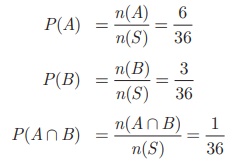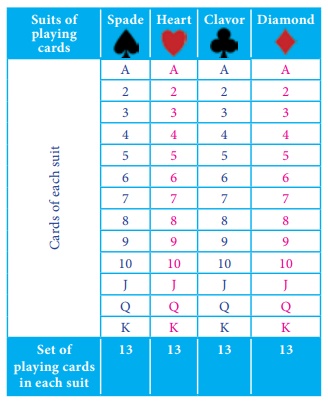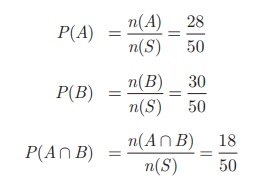Proof, Example Solved Problem | Mathematics - Addition Theorem of Probability | 10th Mathematics : UNIT 8 : Statistics And Probability
Chapter: 10th Mathematics : UNIT 8 : Statistics And Probability
Addition Theorem of Probability
Addition
Theorem of Probability
(i) If A and B
are any two events then
P (A ∪ B ) = P(A) + P(B ) −P(A
∩ B)
(ii) If A,B and C
are any three events then
P (A ∪ B ∪ C) = P (A) + P
(B) + P (C) − P (A ∩ B ) − P(B
∩C) −P (A ∩C ) + P(A ∩ B ∩C)
Proof
(i) Let A and B
be any two events of a random experiment with sample space S.
From the Venn diagram,
we have the events only A, A Ո B and only B are
mutually exclusive and their union is A U B
Therefore, P (A
U B) = P[ (only A) ∪(A ∩ B) ∪
(only B) ]
= P(only A) +P
(A ∩ B) + P(only B)
= [P (A) −P
(A ∩ B )] + P(A ∩ B) +[P (B )
− P (A ∩ B)]
P (A U B)
= P (A) + P (B ) − P (A
∩ B)

(ii) Let A, B, C
are any three events of a random experiment with sample space S.
Let D = B ∪C
P (A U B UC)
= P (A ∪ D)
= P (A) + P
(D ) − P (A ∩ D)
= P (A) + P
(B ∪ C ) − P[A ∩ (B ∪C)]
= P (A) + P
(B) + P(C ) − P(B ∩C) − P [(A
∩ B ) ∪ (A ∩C)]
= P (A) + P (B)
+ P (C) − P (B ∩C ) − P(A ∩ B)
− P (A ∩C ) + P[(A ∩ B) ∩ (A ∩C)]
P (A U B UC) = P (A) + P (B) + P (C) − P (A ∩ B ) − P(B ∩C) −P (C ∩ A) + P(A ∩ B ∩C)
Example 8.27
If P(A) = 0.37 , P(B) = 0.42 , P (A ∩ B) = 0.09 then find P (A U B) .
Solution
P(A) = 0.37
, P(B) = 0.42 , P (A ∩ B)
= 0.09
P (A U B)
= P (A) + P (B ) − P (A
∩ B)
P (A U B)
= 0.37 + 0.42 − 0.09 = 0.
7
Example 8.28
What is the probability
of drawing either a king or a queen in a single draw from a well shuffled
pack of 52 cards?
Solution
Total number of cards =
52
Number of king cards = 4
Probability of drawing a
king card = 4/52
Number of queen cards =
4
Probability of drawing a
queen card= 4/52
Both the events of
drawing a king and a queen are mutually exclusive
⇒ P (A ∪ B) = P (A)
+ P (B)
Therefore, probability
of drawing either a king or a queen = 4/52 + 4/52 = 2/13
Example 8.29
Two dice are rolled
together. Find the probability of getting a doublet or sum of faces as 4.
Solution
When two dice are rolled
together, there will be 6×6 = 36 outcomes. Let S be the sample space. Then n (S) = 36
Let A be the
event of getting a doublet and B be the event of getting face sum 4.
Then A =
{(1,1),(2,2),(3,3),(4,4),(5,5),(6,6)}
B = {(1,3),(2,2),(3,1)}
Therefore, A
Ո B = {(2,2)}
Then, n (A)
= 6 , n (B) = 3 , n (A ∩ B) = 1.

Therefore, P
(getting a doublet or a total of 4) = P (A U B)
P (A U B)
= P (A) + P (B ) − P (A
∩ B)
= 6/36 + 3/36 – 1/36 = 8/36
= 2/9
Hence, the required
probability is 2/9.
Example 8.30
If A and B
are two events such thatP (A) = 1/4 , P (B) = 1/2
and P(A and B)= 1/8, find (i) P (A or B)
(ii) P(not A and not B).
Solution
(i)
P (A or B)
= P (A U B)
= P (A) + P
(B ) − P (A ∩ B)
P (A or B)
= 1/4 + 1/2 – 1/8 = 5/8
(ii)
P (not
A and not B) = P (![]() ∩
∩ ![]() )
)
= P 
= 1 − P (A
∪
B)
P(not A and not
B) = 1 – 5/8 = 3/8
Example 8.31
A card is drawn from a
pack of
52 cards. Find the
probability of getting a king or a heart or a red card.
Solution
Total number of cards = 52; n(S)
= 52

Let A be the
event of getting a king card. n(A) =4

Let B be the
event of getting a heart card. n(B) =13

Let
C be the event of getting a red card. n(C) =26

P (A Ո B) = P
(getting heart king) = 1/52
P (B ՈC) = P
(getting red and heart)) = 13/52
P (A ՈC) = P
(getting red king) = 2/52
P (A Ո B ՈC)
= P (getting heart, king which is red) = 1/52
Therefore, required
probability is
P (A U B UC)
= P (A) + P (B) + P (C)
− P (A ∩ B ) − P(B ∩C) −P
(C ∩ A) + P(A ∩ B ∩C)
= 4/52 + 13/52 + 26/52 – 1/52 – 13/52 – 2/52 + 1/52 = 28/52

= 7/13
Example 8.32
In a class of 50 students, 28 opted for NCC, 30 opted for NSS and 18 opted both NCC and NSS. One of
the students is selected at random. Find the probability that
(i) The student opted
for NCC but not NSS.
(ii) The student opted
for NSS but not NCC.
(iii) The student opted
for exactly one of them.
Solution
Total number of students
n (S) = 50 .
Let A and B
be the events of students opted for NCC and NSS respectively.
n (A) = 28
, n (B) = 30 , n (A ∩ B)
= 18

(i) Probability of the
students opted for NCC but not NSS
P (A Ո ![]() )
= P (A) −P (A ∩ B) = 28/50 – 18/50 =1/5
)
= P (A) −P (A ∩ B) = 28/50 – 18/50 =1/5
(ii) Probability of the
students opted for NSS but not NCC.
P (A Ո ![]() ) = P (B ) −P (A ∩ B) = 30/50 – 18/50 =
6/25
) = P (B ) −P (A ∩ B) = 30/50 – 18/50 =
6/25
(iii) Probability of the
students opted for exactly one of them

(Note that (A Ո ![]() ),
(
),
(![]() Ո B) are mutually exclusive events)
Ո B) are mutually exclusive events)
Example 8.33
A and B are two candidates
seeking admission to IIT. The probability that A getting selected is 0.5 and
the probability that both A and B getting selected is 0.3. Prove
that the probability of B being selected is atmost 0.8.
Solution
P (A) = 0.5
, P (A ∩ B) = 0.3
We have P (A U
B ) ≤ 1
P (A) + P(B)
−P (A ∩ B) ≤ 1
0.5 + P (B)
− 0.3 ≤ 1
P (B) ≤ 1 − 0.2
P (B) ≤
0.8
Therefore, probability
of B getting selected is atmost 0.8.
Related Topics